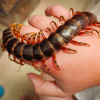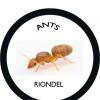It's called Hebel block in the USA maybe they can ship some to your address: http://www.hebel-usa...ex.php#_sub1405
- Formiculture.com
- Forums
- Gallery
- Members
- Member Map
- Chat

It's called Hebel block in the USA maybe they can ship some to your address: http://www.hebel-usa...ex.php#_sub1405
AAC can only be bought by the pallet in the US.
Good selection of musics for your videos. When I feed the cockroaches to my colony I had to kill it, otherwise it kick up too much surroundings and destroy the structure of the outworld.
deleted
Edited by Barristan, April 29 2017 - 1:19 PM.
One thing I noticed, and we're all guilty of this sometimes, I suppose, is that you are only utilizing about 50% of the usable area of those blocks for chambers and tunnels.
Certainly it would take more time and skill to make walls thinner, but it looks like you could have actually fit just as much usable space in a single block, as you decided to fit into two.
Yes that's true and since I don't have a lot of skill in nest building I am very careful and don't make chambers too close to each other. I destroyed a lot of ytong bricks by making chambers too close to the exterior wall so it bursted... if you have a router you can also do much more precise work. However the milling heads won't last very long.
PS: It's a single block but two glass panels.
Edited by Barristan, March 8 2016 - 10:23 AM.
deleted
Edited by Barristan, April 29 2017 - 1:19 PM.
deleted
Edited by Barristan, April 29 2017 - 1:19 PM.
That is some intense hugging you've got there.
You're colony grew really huge, really quick! On par with how my Solenopsis invicta colony was, if not even faster.
Is Pheidole pallidula an invasive species? Or do they just get big colonies? Cause here in California, all the native Pheidole never grow like that at all. Maybe Pheidole hyatti, but they still don't get colonies like that. The only one that does is Pheidole megacephala, and that is not native and invasive.
Edited by Vendayn, March 9 2016 - 8:29 PM.
Yes the growth rate is impressive. I kept this species already several years ago. The former colony did also grow fast but not as fast as the new one.
This species isn't invasive. It's native to southern Europe. Someone who keeps Pheidole megacephana told me that not even that species grows that fast.
deleted
Edited by Barristan, April 29 2017 - 1:19 PM.
The pictures. ![]()
Yes the growth rate is impressive. I kept this species already several years ago. The former colony did also grow fast but not as fast as the new one.
This species isn't invasive. It's native to southern Europe. Someone who keeps Pheidole megacephana told me that not even that species grows that fast.
Do Pheidole pallidula have multiple queens? From my experience, Pheidole megacephala DO grow really fast. However, they start super slow. Pheidole megacephala however make supercolonies with hundreds or even thousands of queens, each producing approximately almost 300 eggs a day (at least that is what I read, not sure if accurate). Pheidole megacephala produce alates and mate in captivity. In the wild, they mate underground and also fly (though some locations they don't fly for some reason). Ph. megacephala do seem to expand a lot slower than Argentine ants and Solenopsis invicta however, at least for the first year. Not sure how fast or how much the Ph. megacephala will expand this year, but the first year (last year) they didn't expand that much around here. Granted, the apartments DID do a huge pest control with pesticides and ant baits due to me telling them about it.
Pheidole megacephala do seem to win very easily against Argentine ants, however. I notice they have an upper hand in their battles against them.
Edited by Vendayn, March 10 2016 - 8:06 PM.
I generally avoid meat products, as they tend to smell badly when ants break them into particles for storage in the nest.
One I've seen referenced repeatedly in literature, however, is beef liver. Organ meat appears to have far more nutrients compared to non-organs.
I haven't had this problem yet. But I see the small parts stored inside the nest. However they only store them at a dry part of the nest. This species is quite good at preventing mold etc. They only keep stuff inside the nest which they will need in near futere. Everything else is dumped outside in the outworld.
I think I will give beef liver a try ![]() Than I'll call them Pheidole hanniballecteria.
Than I'll call them Pheidole hanniballecteria.
Yes the growth rate is impressive. I kept this species already several years ago. The former colony did also grow fast but not as fast as the new one.
This species isn't invasive. It's native to southern Europe. Someone who keeps Pheidole megacephana told me that not even that species grows that fast.Do Pheidole pallidula have multiple queens? From my experience, Pheidole megacephala DO grow really fast. However, they start super slow. Pheidole megacephala however make supercolonies with hundreds or even thousands of queens, each producing approximately almost 300 eggs a day (at least that is what I read, not sure if accurate). Pheidole megacephala produce alates and mate in captivity. In the wild, they mate underground and also fly (though some locations they don't fly for some reason). Ph. megacephala do seem to expand a lot slower than Argentine ants and Solenopsis invicta however, at least for the first year. Not sure how fast or how much the Ph. megacephala will expand this year, but the first year (last year) they didn't expand that much around here. Granted, the apartments DID do a huge pest control with pesticides and ant baits due to me telling them about it.
Pheidole megacephala do seem to win very easily against Argentine ants, however. I notice they have an upper hand in their battles against them.
They normally only have one queen. Sometimes in nature you can find nests which contain two or more queens but that is not the rule. They often found in pleometrosis but after founding all queens except for one get killed. I've never seen a Pheidole megacephala colony in nature it must be a quite impressive sight. I noticed that polygynous species grow slower if they only have one queen but with several queens growth rate will be higher than that of a monogynous species.
deleted
Edited by Barristan, April 29 2017 - 1:20 PM.
Cool, they breaded it.
deleted
Edited by Barristan, April 29 2017 - 1:20 PM.
Ant Keeping →
General Ant Keeping →
Need some advice on my Pheidole Parva's tubeStarted by Chime , Feb 13 2024 |
|

|
||
Ant Keeping →
Ant Keeping Journals →
SHmealer's Pheidole carrolliStarted by SHmealer , Oct 22 2023 |
|

|
||
Ant Keeping →
Ant Keeping Journals →
Mish's Pheidole anastassi JournalStarted by Mikezee , Oct 3 2023 |
|

|
||
Ant Keeping →
Ant Keeping Journals →
bmb1bee's Micro-sized Miscellanies (updated 9/21/23)Started by bmb1bee , Sep 21 2023 |
|

|
||
Ant Keeping →
Ant Keeping Journals →
SHmealer's Pheidole littoralisStarted by SHmealer , Aug 9 2023 |
|

|
0 members, 0 guests, 0 anonymous users